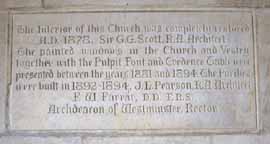
Detail from the Memorial to Dean Farrar in the porch of St Margaret's Church, Westminster. Click on thumbnail for larger image.
Frederic William (better known by his later title of Dean) Farrar, is now remembered chiefly as the author of the moralistic school story, Eric or, Little by Little: A Tale of Roslyn School (1858, a year after Hughes's more robust hero, Tom Brown, first appeared). The tale was hugely popular at the time, and is recognised now, at last, as making a discreet but nevertheless brave attempt to "guide and control the sexual life of his [young] readers" (Bratton 158). But Farrar, who was born as the son of a missionary in India, took his London BA in 1852 and became a major public figure, deserves to be remembered for far more than this one children's story.
After going on from King's to distinguish himself at Cambridge and become a Fellow of Trinity College there, Farrar took up a career as a public school teacher. He taught briefly at Marlborough (one of the newer public schools at that time, since it was founded only in 1843) and then for over fifteen years at Harrow, where he became a housemaster. While at Harrow, he wrote not only Eric, but two more popular novels about school and college life, and a number of influential philological works. Perhaps most importantly of all, in 1867 he gave a controversial lecture at the Royal Institution entitled "Defects in Public School Education," which usefully attacked the dependence of these schools on classical verse composition as an educational tool. Farrar himself was a keen botanist who inspired his pupils to respond more spontaneously to the natural world, and to study a whole range of subjects — science, English literature and language, and the arts generally. His timely book, Essays on a Liberal Education, was published in the same year (1867). In 1871, Farrar returned to Marlborough as a vigorous headmaster who worked hard to get the best out of everyone, staff and pupils alike.
This would have been enough for most men. But Farrar had another career ahead of him. In 1869 he had been made an honorary chaplain to Queen Victoria, and he was now becoming more and more prominent in theological circles. The fruits of his Biblical scholarship were as popular as his earlier writings. Indeed, his Life of Christ (1874), still surprisingly fresh and highly readable today, ran to 30 editions and was widely translated. It is the less surprising, then, that he left Marlborough in 1876 to become Canon of Westminster and Rector of St Margaret's Church in the Abbey grounds (the appointments normally go together). He rose to be Archdeacon of Westminster in 1883, Chaplain to the speaker of the House of Commons in 1890, and Dean of Canterbury in 1895.


St Margaret's Church in the Abbey grounds with Big Ben behind. Restored by Sir George Gilbert Scott.
Plaque commemorating the restoration. Click on thumbnails for larger images
Whilst at Westminster, Farrar saw the third of his five daughters married to one of his curates, Henry Hutchinson Montgomery, who had once been his pupil at Harrow, and would one day be the Bishop of Tasmania — and father of Viscount Montgomery. A family memoir of Montgomery tells of Farrar's tremendous popularity as a preacher: "when Canon Farrar preached in the Abbey on Sunday evenings, the notice 'Abbey full' sent an overflow congregation to St Margaret's." The memoir also says a little about Farrar's restoration of this church, the last resting-place of William Caxton and Sir Walter Raleigh, and the place where John Milton worshipped. Farrar was a long-time disciple of Ruskin, and a keen admirer of Holman Hunt; deeply interested in and knowledgeable about both architecture and art, he involved himself personally in the restoration project, for which he engaged the services of Sir George Gilbert Scott. No wonder the results were "wonderful" (unfortunately, photography is not allowed inside the church now). The Montgomery memoir records as well that this many-sided and energetic Victorian was "the most affectionate and generous of fathers-in-law."
Related material
References
Bratton, J. S. The Impact of Victorian Children's Fiction. London: Croom Helm, 1981.
Farrar, F. W. The Life of Christ." Viewed 22 February 2007.
Hearnshaw, F. J. C. The Centenary History of King's College, London, 1828-1928. London: Harrap, 1929.
Montgomery, M. Bishop Montgomery: A Memoir." Viewed 15 February 2007.
Vance, Norman. "Farrar, Frederic William (1831-1903)." Oxford Dictionary of National Biography. Online ed. Viewed 15 February 2007.
Last modified 14 April 2015